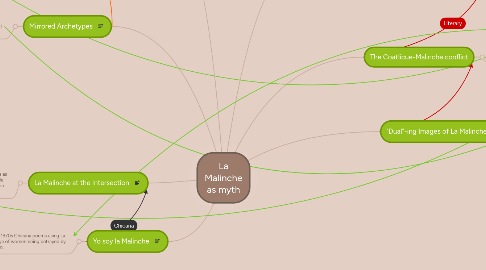
1. La Malinche, feminist prototype
1.1. This work tells the story of what we know of Malinche and defends her actions
1.1.1. Malinche, a princess, was abandoned by her own mother to ensure her half- brother would inherit the family inheritance. As a slave she learned both Mayan and Nahuatl. Given as a gift to Cortes, her noble upbringing allowed her to rise up the ranks and garner respect. She was invaluable and went above in beyond in her work. The lover of Cortes, he respected her enough to name their son after his own father,
1.1.2. Malinche was not able to predict the future, so she should not be blamed for the fall of her empire. She may have assimilated with whites, but as an outcast of her own people, she was justified in doing so. Even if she did try to prevent the Spanish victory, it would be naive to assume she would have been successful in stopping their conquest.
2. La Malinche at the Intersection
2.1. Exposes how Chicanos and other males have referenced la Malinche as the "fucked mother". Men have placed their responsibility on a female figure, using her as their scapegoat. Sanchez uses "Down These Mean Streets" as an example.
2.1.1. Chicanos use this image as a symbol of allowing whites to suppress them (a raped woman).
2.1.2. Chicanas (Mexican american feminists) have tried to replace this chingada (fucked) image for the depiction of Malinche as "la lengua'- the bridger between two worlds.
3. Mirrored Archetypes
3.1. Downs juxtaposes the two indigenous stories of Pocahontas and Malinche: the pure virtuous virgin and the traitorous whore.
3.1.1. Claims
3.1.1.1. Only recently has Malinche's image become sexualized.
3.1.1.2. focusing on her failure takes blame away from the male soldiers of her time
3.1.1.3. She is a 'slut' not because of an abundance of partners, but because of the race of her partners
3.1.1.4. Her story is so differently told from Pocahontas because Pocahontas was created through the eyes of the conquerors, whilst Malinches story was told from those who lost their land.
3.1.1.5. To this day chicanas who marry Anglo men are referred to as "malinchista" (traitor).
4. Yo soy la Malinche
4.1. A analysis of several 1970s Chicana poems using La Malinche as the image of women being betrayed by the men around them.
4.1.1. includes references to Paz's work, which depict a male understanding of Mexico being the bastard son of the disgraced Malinche, an image that is not good for nationalism.
5. Past and Present in Victor Hugo Rascon Banda's La Malinche and Marisol Martin del Campo's Amor Conquista
5.1. A review of La Malinche's portrayal in La Banda's "La Malinche" and del Campo's novel
5.1.1. Claims
5.1.1.1. La Malinche is traditionally portrayed as either the traitor, the mother, or aid to Europeans
5.1.1.1.1. The traitor: willingly caused the destruction of her homeland and people
5.1.1.1.2. Mother: the, although dirty, mother of a new race
5.1.1.1.3. Aid: the godsend for the Europeans to spread the gospel
5.1.1.2. The only way to properly showcase Malinche as a person is to have the character only react to her present situations and not, through the removal of foreshadowing, seem to be ignorant of cases obvious to the audience.
5.1.2. Flaws: Does not address Malinche's portrayal as a loose woman.
6. "Dual"-ing Images of La Malinche
6.1. Mexican female role models are reduced to two: la Virgen de Guadalupe and La Malinche
6.1.1. La Virgen is all that is praiseworthy and pure of the indigenous- it is was is truly the good feminine Mexican
6.1.2. La Malinche is all that is bad, the betrayer of her native lands. She is a loose woman and an undesirable.
6.1.3. There is no middle ground between these two figures
7. The Coatlicue-Malinche conflict
7.1. Fuente writes of women who suffer from a Coatlicue-Malinche effect
7.1.1. These women have been raped or abandoned (Malinche) yet they want to seperate themselves from the earthly conception of their child and desire to be like Coatlicue
7.1.1.1. Coatlicue was a deity who gave birth to her immaculately conceived child Huitzilopochtli daily, as he would protect her from her other angry offspring
7.1.1.2. Malinche is used as an allusion for battered and abandoned women
